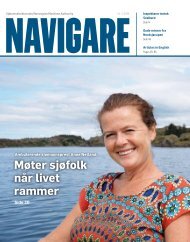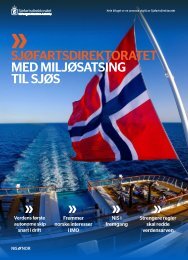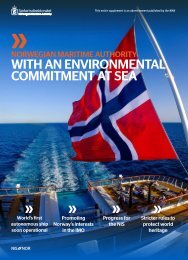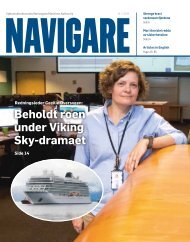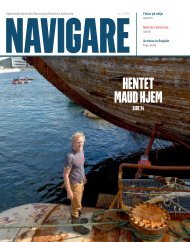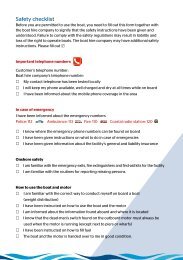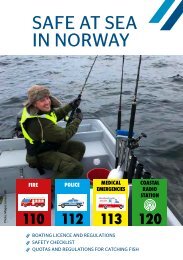Create successful ePaper yourself
Turn your PDF publications into a flip-book with our unique Google optimized e-Paper software.
news<br />
english translation from page 14<br />
Capsizing and sinking of workboat Målfrid:<br />
Insufficient ship technical<br />
expertise<br />
The risk assessment of the company had not identified the risks associated with<br />
the use of crane while the inspection hatch is open. This is probably due to<br />
insufficiently comprehensive ship technical expertise, the Accident Investigation<br />
Board Norway (AIBN) states in their analysis of the foundering of the workboat<br />
Målfrid outside Karmøy in May 2<strong>01</strong>7.<br />
Bjarte Amble, Journalist of <strong>Navigare</strong><br />
The workboat Målfrid foundered during<br />
operation at a fish farm north of Karmøy on<br />
12 May 2<strong>01</strong>7. One of the lines running from<br />
the floating collar of the fish cage to the<br />
bottom ring (bottom ring rope) had entangled<br />
the starboard propeller.<br />
The crew responded by opening the<br />
inspection hatch above the propeller to get a<br />
better picture of the situation. To release the<br />
line from the propeller, the crew attempted to<br />
use the vessel’s crane to lift the next bottom<br />
ring line. The lifting operation led to an<br />
increased draft on the vessel’s starboard side,<br />
which in turn resulted in water flowing freely<br />
through the open inspection hatch. The vessel<br />
sank, but neither crew member was injured.<br />
THE ASSIGNMENT<br />
Two employees of the company NRS Feøy<br />
were about to clean the floating collar and the<br />
bottom ring of one of the fish cages at the<br />
company’s location outside North Karmøy.<br />
The cage was empty, and cleaning was part of<br />
the preparation for releasing new smolt later<br />
that summer.<br />
The work would be undertaken using the<br />
workboat Målfrid, a catamaran (two hulls) of<br />
14,98 metres in overall length. The expected<br />
duration of the task was one to two days.<br />
Before the cleaning operation could start,<br />
the bottom ring had to be lifted. The bottom<br />
ring is located under the floating collar, to<br />
which it is attached by 20 bottom ring lines,<br />
each about 20 metres long. The crew were to<br />
attach Målfrid‘s crane to one bottom ring line<br />
after the other and lift the bottom ring up<br />
under the floating collar, where it would be<br />
locked.<br />
One of the crew members was on board<br />
operating the vessel and crane, while the other<br />
was on the floating collar attaching and<br />
detaching the crane hook from and to the<br />
bottom ring lines as Målfrid was moving along<br />
the floating collar.<br />
THE CASUALTY<br />
As the crew worked their way around the fish<br />
cage, one of the bottom lines entangled the<br />
starboard propeller. The lifting of an adjoining<br />
line had left slack in this line. Subsequently,<br />
the crew moored the vessel with the stern<br />
against the floating collar, opened a deck hatch<br />
and climbed down into the engine room. They<br />
removed the door into the aft engine room<br />
bulkhead and localised the inspection hatch<br />
above the starboard propeller.<br />
After an unsuccessful attempt to loosen the<br />
line, the two agreed to release the entangled<br />
line by lifting the adjoining bottom ring line by<br />
using of the crane. This was done, but the<br />
inspection hatch was still open and the door to<br />
the bulkhead removed.<br />
As the lifting operation began, the crane<br />
moved sideways towards the starboard side,<br />
and after a short while, the person operating<br />
the crane noticed that the freeboard was<br />
reduced and water flowed over the aft<br />
starboard corner of the deck as the listing<br />
increased.<br />
The other crew member then suddenly<br />
started to think of the possibility that the<br />
moment of the crane could allow water to seep<br />
in through the inspection hatch. He instantly<br />
shouted to alert his colleague to what was<br />
about to happen. Several attempts to save the<br />
situation failed and eventually, the person on<br />
board jumped into the sea from the starboard<br />
side. His vest inflated immediately, and with<br />
the assistance of his colleague, he managed to<br />
climb onto the floating collar, from which both<br />
men were rescued by a passing boat.<br />
Målfrid sank to the bottom of the sea, at<br />
approximately 40 metres deep. Neither crew<br />
member was injured or needed medical<br />
attention.<br />
THE CAUSE<br />
In their analysis of the casualty, the AIBN<br />
establishes that the crew conducted a lifting<br />
operation with the vessel’s crane while the<br />
inspection hatch above the starboard propeller<br />
was open. This resulted in flooding of the<br />
starboard hull, which caused Målfrid to<br />
capsize and sink.<br />
Operational barriers could have stopped<br />
the crew from using the crane for lifting<br />
operation while the inspection hatch and the<br />
door to the engine room were open. There<br />
were no instructions or warnings about the use<br />
of the inspection hatch.<br />
“Thorough risk assessments are an<br />
important tool in establishing operational<br />
barriers,” the AIBN concludes in the report.<br />
For Målfrid, relatively extensive risk<br />
58 | <strong>Navigare</strong> 1 - 2<strong>01</strong>9










